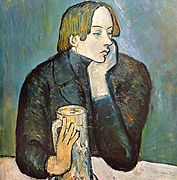Grade Four - Art as it Changes
Lesson 7 –‘‘Picasso and his Friends”
INTRODUCTION
Pablo Picasso was a Spanish painter, sculptor, printmaker, ceramicist, stage designer, poet and playwright who spent most of his adult life in France. Regarded as one of the most influential artists of the 20th century, he is known for co-founding the Cubist movement, the invention of constructed sculpture, the co-invention of collage, and for the wide variety of styles that he helped develop and explore.
The total number of artworks Picasso produced has been estimated at 50,000, comprising 1,885 paintings; 1,228 sculptures; 2,880 ceramics, roughly 12,000 drawings, many thousands of prints, and numerous tapestries and rugs. The medium in which Picasso made his most important contribution was painting.
The main phases of his Picasso's art (as the world and his life changed, so did his art) were:
1. Blue Period (1903-5). Sad, gaunt people in gloomy settings, and then circus and harlequin subjects. The predominant colour is a melancholy blue.
Example: "The Tragedy" 1903
2. Rose Period (1905-6). Romantic, delicately treated subjects in pale pink. Example: "Acrobat and Young Harlequin" 1906.
3. Cubism (1907-25, includes the Proto-Cubist, Analytical and Synthetic Periods). Natural forms were changed to geometric-like shapes. Distortion and multi-view figures in mainly dull colours. Examples: "Three Musicians" 1921.
4. Neo-Classicism (1920-30). Heavily-built sculpturesque Grecian women. Example: "The Lovers" 1923.
5. Surrealism (1926 onwards). Dream-world compositions. Example: "Guernica" 1937.
6. A style reminiscent of stained glass (1932 onwards). Grotesque conventionalized and disjointed forms outlined with thick black lines. Examples: "Interior with girl drawing" 1935.
7. A style with strong expressionist elements (1938 onwards). Subjects that anticipate the terror of war and reveal the conflict in his mind. Double images and extreme distortion. Example: "Two women by the sea".
Additional Links: Pablo Picasso Biography


MATERIALS
1. Mother and Child and four studies for a Right Hand, 1904,
Pablo Picasso, Spanish (1881-1973) Harvard University, Cambridge, MA.
2. The Tragedy, 1903, Pablo Picasso, Spanish (1881-1973)
National Gallery of Art, Washington, DC
3. Portrait of Jaime Sabartes, 1901, Pablo Picasso, Spanish (1881-1973)
Pushkin Museum, Moscow. Reproduction print
4. Acrobate et Jeune Arlequin (Acrobat and Young Harlequin), Pablo Picasso, 1905
5. Landscape, (Mount Sainte-Victoire), 1904, Paul Cezanne, French (1893-1906)
Addison Gallery of Art, Andover, MA
Cezanne influenced Picasso. He admired color and flat shape.
6. The Aficionado, 1911-12, Pablo Picasso, Spanish (1881-1973) Kunsthaus, Zurich, Switzerland
7. Violin and Pipe, 1911-2, Georges Braque, French (1882-1963) The Phillips Collection, Washington, DC
Braque was a contemporary of Picasso. The term collage was coined by both Georges Braque and Pablo Picasso in the beginning of the 20th century when collage became a distinctive part of modern art.
8. The Three Musicians, 1921, Pablo Picasso, Spanish (1881-1973)
9. The Lovers, 1923, Pablo Picasso, Spanish (1881-1973)
National Gallery of Art, Washington, DC.
10. Guernica, 1937, Pablo Picasso, Spanish (1881-1973) The Museum of Modern Art, New York, NY
11. Don Quixote, 1955, Pablo Picasso, Spanish (1881-1973)

1.

2.

3.
4.


5.
6.


7.
8.


9.

9.
10.

